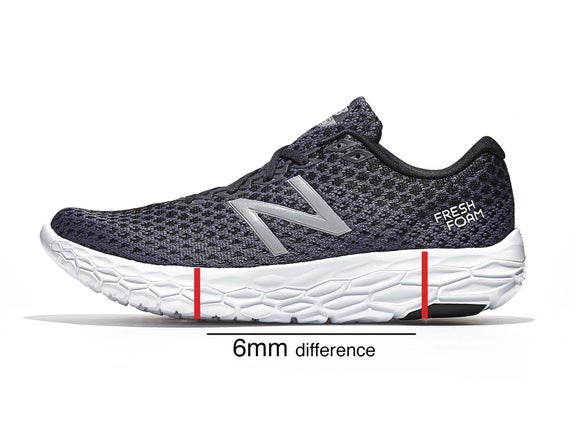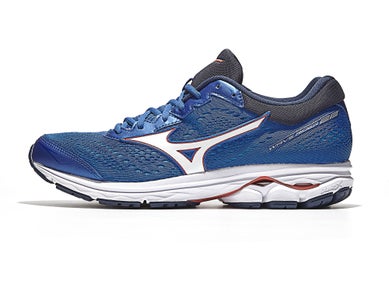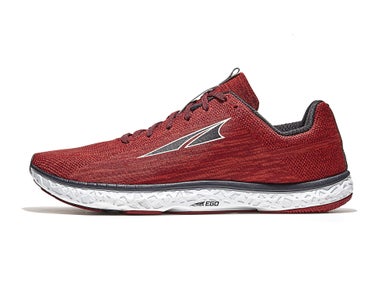Running Shoe Offsets Explained
How the Drop of Your Shoe Can Affect Your Running Experience
Updated: 3 October 2024
What is Heel to Toe Drop?
Heel to toe drop, sometimes referred to as offset, is the difference in the amount of material under the heel and the amount of material under the forefoot of a shoe. Drop is usually given in a number of millimeters. For example, a shoe with 20 mm of material under the forefoot and 26 mm of material under the heel would have a heel-toe drop of 6 mm.
Most running shoes have more material under the heel to help absorb the impact of landing. Running shoes with a lower heel to toe drop have a more uniform thickness of material under the entire foot.

Does Shoe Drop Matter?
Heel to toe drop is not a highly important factor when selecting your first running shoes. Instead, you'll want to think about comfort as the biggest consideration. Learn more about how to select your first running shoes in our guide for beginners. You can start thinking about heel to toe drop when it comes time to replace your shoes or broaden your running shoe lineup. Having said that, a shoe's heel toe drop can be important if you have a history of injury or reoccurring pressure in certain areas.
What is the Best Amount of Drop?
There is no magical amount of heel to toe drop that is best for everyone. However, there are some general guidelines that may help you find your ideal level of shoe drop, taking into consideration your foot strike when running, the shape of your feet, and any injuries you may have.
- A high heel-toe drop (over 7 mm) is best for runners who land heel first, have issues with their Achilles tendon, or who often wear shoes with an elevated heel.
- A low heel-toe drop (from 0 to 6 mm) is best for runners who land on the middle or front of the foot.
If you need help determining your foot strike, you are welcome to submit a video online for our Running Warehouse experts to analyse your gait.
Your foot type can also play a role in determining what drop is best for you. For people with flat feet, moderate heel drop is recommended for extra support and cushioning. Conversely, people with higher arches benefit from a lower heel to toe drop. Zero-drop shoes have the same height in the heel and forefoot and also work well for those with high arches.


Is a High or Low Heel-Toe Drop Better?
Is a zero drop shoe best? Is a 10 mm drop too much? It all comes down to personal preference. Some runners claim that a lower offset shoe puts your foot in a better, more natural position. The thinking goes: If you run barefoot, your foot does not have an elevated heel. For runners who hit the ground first with the middle or front of their foot, the extra cushioning on higher-drop shoes doesn't add any value and can just get in the way. These runners often prefer shoes with a lower drop.
However, many people hit the ground with their heels first. Shoes with additional cushioning in the heel can help absorb more impact upon landing. For these runners, high-drop shoes are usually preferred.
In addition to your foot strike, if you have any injuries or weakness, it's important to avoid putting pressure on the injured area and allow the uninjured region to absorb most of the impact when running. Lower-drop shoes will place more of a load on your ankles and Achilles, while a higher heel drop places more pressure on your knees and hips.
So, is either type of offset "better" than the other? No. You may find, however, that a higher or lower-drop shoe is better for you. The science is inconclusive regarding the benefits or issues related to certain drops. At this point, choosing a shoe by drop is a personal preference and comes down to what you like and what feels good on your feet.
What Heel to Toe Drop is Best For Walking?
Since walkers strike with the heel and roll through their steps, there's no need for a high-drop shoe for walking. Generally, shoes used primarily for walking should have a lower drop, less than 8 mm.
A majority of walkers also prefer a shoe that is evenly cushioned rather than one with a large heel stack (more cushioning in the heel than in the toe). Because walking causes less impact on your feet than running, walkers don't need the extra forefoot or heel cushioning and can still feel comfortable with less cushioning.
Stack Height vs. Heel Drop
It is important not to confuse a shoe's stack height with a shoe's offset. As we discussed earlier, heel to toe drop is the difference measured between how much material is in the heel and the forefoot of a shoe, while stack height refers to the amount of cushioning in the shoe's midsole, separating your feet from the ground. A low stack height shoe would offer more ground feel and responsiveness, whereas a higher stack height provides more underfoot protection and shock absorption. A shoe with more cushioning will have a higher stack height, while a shoe with less cushioning will have a lower stack height. To learn more, check out our article, What is Stack Height?
Note: A low heel to toe drop doesn’t necessarily mean a low stack height and vice versa. For example, HOKAs are known for their low-drop and high-stack shoes. A lower-drop shoe does not equate to a lighter shoe either. Altra put zero-drop shoes on the map, but they still have solid cushioning and arch support.
Guidelines for Selecting Shoes By Drop
- When choosing your first running shoes, comfort should be your main consideration, not drop.
- To calculate the drop of a shoe on the Running Warehouse site, look at the stack height numbers in the shoe's description. Subtract the forefoot number from the heel number.
- Switching between shoes of different drops might be a good idea, as your foot will react slightly differently to different drops. This may reduce repetitive stress injuries commonly associated with running.
- If you choose a shoe with a drop more than 4 mm different than your current shoe, it is advisable to gradually transition to the new shoe. Especially when switching to a lower-drop shoe, it is not uncommon to experience some soreness in your calf or Achilles tendon during the transition phase.
- Since runners strike the ground first with different parts of their foot, the type of foot strike (heel, midfoot, or forefoot) helps determine the amount of drop that will work best for you.
- Low-drop and zero-drop shoes push feet forward during running, supporting a more natural mid/forefoot strike.
- Shoes with a higher heel drop favour heel strikers.
- For walkers, the optimal heel drop is < 8 mm.
- The ideal shoe drop is the one that works for you. Prioritise a comfortable fit above all else.


